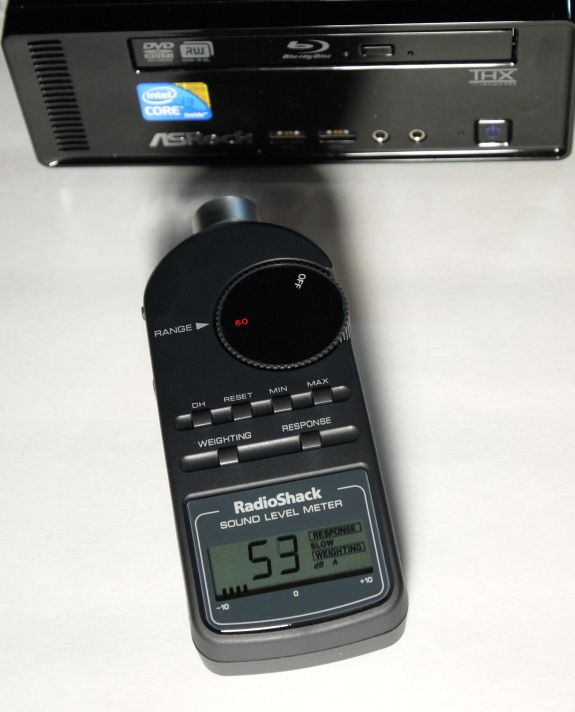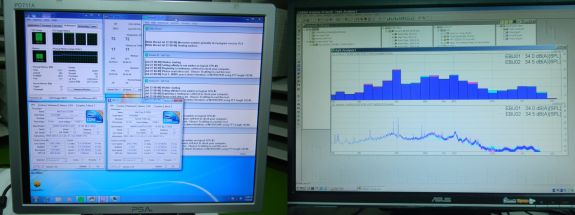ASRock Core 100HT-BD : Bringing HTPCs to the Mainstream Market [UPDATED : Noise Issue]
by Ganesh T S on July 19, 2010 9:34 PM EST- Posted in
- Home Theater
- Arrandale
- ASRock
- Media Streamer
- Core i3
- HTPC
HTPC enthusiasts are rightly concerned about the noise factor, heat and power consumption, ease of usage and many other criteria. We will tackle each of these concerns one by one in this section.
Noise
ASRock claims that the Core 100 HT-BD produces less than 25dB of noise. Under lab testing conditions, such performance is indeed possible. We decided to get hold of one of the sound meters used in setting up home theater speakers to verify whether the claims were true. Being a hobbyist sound meter, it wasn't very sensitive. The measurable sound range was only 50 - 130 dB, and there was a concern that the Core 100 would be too silent for the sound meter to pick up. As it turned out, while running Prime95 at full throttle (100% CPU utilization), the fans kicked in at full speed. The sound meter registered between 53 and 55 dB very close to the unit. [ See UPDATE below for a more practical measurement ]
The fan noise is quite audible if one sits very close to the unit. From 8 ft away, even with the unit in the open, we could barely hear it. Noise, however, is a very subjective issue. We hope the quoted number will help give readers an idea of how noisy the system gets when fully loaded. If the unit is going to be installed inside a cabinet of some sort, the noise factor becomes a non-issue.
UPDATE: One of the reasons we kept our sound detector very close to the unit was because it refused to register any measurement at the usual practical distances. While waiting to get hold of a more sensitive sound meter, we asked ASRock for lab results of sound measurement at full throttle. They were happy to oblige us with the following photographs and video from their anechoic chamber. It appears that the sound level is less than 35dB at a distance of 2 ft. even with all fans in action.
Power Consumption
In order to get an idea of the power consumption numbers, the Prime95 benchmark was let run overnight to keep the system completely loaded for an extended duration. All the four 'cores' of the CPU were pegged at 100% throughout, and we found an average power consumption of less than 48 W. At idle, the system consumed around 18 W.
These type of power consumption numbers have been enabled by ASRock's choice of going in for an Arrandale instead of a Clarkdale platform. This has resulted in a smaller form factor case design for the mini-ITX motherboard. Since there is not much heat to be dissipated, the cooling system is also appropriately small and silent.
Ease of Use
HTPC enthusiasts are concerned about how easy it is for their system to come out of standby. Existence of HDMI handshake issues upon return from standby is also a deal breaker for many. Fortunately, the Core 100 HT-BD has no issues in these two aspects. As long as the AC power adapter is connected to the system, the bundled MCE remote can be used to boot the system (even if the PC had been shut down previously). In order to shorten the boot times, ASRock supplies an Instant Boot utility. Using this, whenver the Core 100 HT-BD is shut down, it boots up once again and shuts down before the power can be safely removed. Upon power up, the boot up is instantaneous. If the user wants to put the PC in sleep mode, ASRock also supplies a Goodnight LED feature in the BIOS, which turns off the bright blue blinking LED in front. The MCE remote can also be used to bring the PC out of sleep mode.
Within Windows, the MCE remote can be made to work with a variety of applications such as XBMC, MediaPortal, MPC-HC and of course, Windows 7 Media Center. Blu Ray players such as PowerDVD and ArcSoft TMT can also be controlled with the help of the MCE remote. For the ideal I/O scenario, one probably needs to purchase a wireless keyboard / mouse combo.
It was seen in an earlier section that the Core 100 HT-BD happened to score quite well in the Anandtech Media Streamer Test Suite. The unit could playback all files using one program or the other, and people expect nothing else from a HTPC. Unfortunately, there is no single unified interface (from XBMC or MediaPortal or any other similar program) which could successfully play back all the files from within. There is definitely an ease of use issue existing here. However, this is not ASRock's fault, and will probably continue to exist on all Clarkdale / Arrandale platforms. Hopefully, projects such as XBMC's DSPlayer mature rapidly to alleviate this problem.













107 Comments
View All Comments
ganeshts - Tuesday, July 20, 2010 - link
erictorch,Thanks for informing me about eWiz carrying the mobile processor. We searched on the usual haunts (Amazon and Newegg), and neither of them carried the processor
I perused further, and it looks like the i3-330M is the only i series processor they have (The i7 mobile they carry has no GPU die in the package and its TDP is 45W).
In any case, I couldn't find a mobo based on the HM55. Are you aware of any with the PGA 988 socket?
By the way, I did see AHCI is selectable in the BIOS, but didn't personally verify whether it works. I will get back to you here in a couple of days if it doesn't :)
erictorch - Tuesday, July 20, 2010 - link
I stumbled upon this list of mini-itx motherboardshttp://www.silentpcreview.com/forums/viewtopic.php...
with froogle.com I was able to find the
IEI KINO-QM57A $320
IBASE MI953F $440
DFI CP100-NRM $400
I was also able to find the i5 mobile CPU through pricewatch.com
ganeshts - Tuesday, July 20, 2010 - link
Thanks for the links, erictorch.At $320 for the board, a build similar to the Core 100 is going to be pretty costly.. We had budgeted $140 for the board.
I wonder how many end users actually end up doing builds based on these mobos.
But you are right! It is possible to do such a build on one's own if the necessary efforts are taken. However, most people will go in for the Clarkdale builds because they are much more cost efficient.
spddemon - Wednesday, July 21, 2010 - link
That is very true, ganeshts; however, I would love to see what the end result would be with one of those boards instead of a clarkdale...I am more than willing to spend a couple hundred more for a true low powered system providing my performance and functionality were not hindered.
I was targeting a Core i3 530 but if the performance per watt of the 330 is close to the 530 then it could be a great trade off.
I will have to add this info to my build sheet and see where it goes.. I have sifted the hardware down quite a bit, but I still have a lot of products to research before i start..
Riccardo - Tuesday, July 20, 2010 - link
Hi Ganesh,Good work on this review - I really appreciate the HTPC focus on this one. I look forward to seeing it used again in relevant reviews. Thanks!
Pessimism - Tuesday, July 20, 2010 - link
I'd pay an extra $5 for a remote that doesn't look so cheesy and cheap. They aren't the only company at fault though. I see a LOT of slick looking devices with cheap, tacky, flimsy looking remotes that don't match up with the look of the device whatsoever.OblivionLord - Tuesday, July 20, 2010 - link
I'm thinking that people would be more inclined to believe your point of using a USB capture card if they knew the real benefit of it compared to a typical PCI Capture card. The only real physical drawback with the USB card is that you need a second one if you want a dual tuner setup.The other problem is that the quality of the captured video produced by a USB card is inferior to a PCI capture card. This is what I've come to believe since I've never owned a USB card for this purpose.
Perhaps you should do a comparison of a few USB capture devices vs PCI capture cards. This will show the truth.
pcfxer - Tuesday, July 20, 2010 - link
I'm surprised that you chose A-weighting for the measurement of the machine. I'm also surprised that you used the Radioshack and took the 53dB as a "solid" measurement. I have the same SPL meter and its accuracy does not live in the 50dB range. It is far more accurate and stable (if you've used this to get any meaningful information you'll know what I mean) 65+dB.That said, I am fully aware of the noise required to gain measurement on that darn thing. That "HTPC" is effing LOUD! Even inside my case I get the good old Lo A-weighted/C-weighted.
ganeshts - Tuesday, July 20, 2010 - link
pcfxer,Thanks for your feedback. I will keep this in mind for future reviews.
Shadowmaster625 - Tuesday, July 20, 2010 - link
Mainstream Market? For $700? I got news for you... there may be millions of mindless drones rushing out to buy iCrap, but this is way above and beyond mainstream for a HTPC. It only costs $100 to build a HTPC. Anything more than that and you may as well go on ebay and buy a notebook with a damaged LCD and use that as a HTPC (assuming it has hdmi out of course).